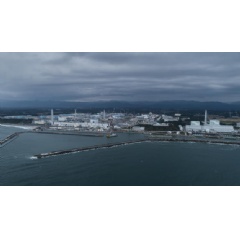Technical failures increase risk of contaminated Fukushima water discharge into Pacific – Greenpeace
The nuclear water crisis at the Fukushima Daiichi plant has been compounded by multiple technical failures and flawed decision making driven by short term cost cutting by the Japanese government and TEPCO, a new Greenpeace Germany analysis concludes.
The report details how plans to discharge over 1 million tonnes of highly contaminated water into the Pacific Ocean was proposed by the same Government task force that ignored alternative options that would have avoided threatening further contamination of the ocean.
“The decision not to develop water processing technology that could remove radioactive tritium was motivated by short term cost cutting not protection of the Pacific ocean environment or the health and livelihoods of communities along the Fukushima coast,” said Kazue Suzuki, Energy Campaigner at Greenpeace Japan. “We have raised the water crisis with the UN International Maritime Organization and firmly stand with local communities, especially fisheries, who are strongly opposed to any plans to discharge contaminated water into their fishing grounds.”
The report concludes that the water crisis remains unresolved, and will be for the foreseeable future. The only viable option to protect the environment and the communities along the Fukushima coast being long term storage for the contaminated water.
The discharge option for water containing high levels of radioactive tritium was recommended as least cost by the Government’s Tritiated Water Task Force and promoted by Japan’s Nuclear Regulation Authority (NRA). The Task Force concluded in 2016 that “sea discharge would cost 3.4 billion yen (US$30 million) and take seven years and four months to complete. It concluded that this was cheapest and quickest of the five methods.” However, technical proposals for removing tritium were submitted to the same Government Task Force by multiple nuclear companies with estimated costs ranging from US$2-US$20 billion to US$50-US$180 billion depending on the technology used. These were dismissed as not viable but without detailed technical consideration.
TEPCO has claimed since 2013 that its ALPS technology would reduce radioactivity levels “to lower than the permissible level for discharge.” However, in September 2018 TEPCO admitted that the processing of over 800,000 tons of contaminated water in 1000 storage tanks, including strontium, had failed to remove radioactivity to below regulatory limits, including for strontium-90, a bone seeking radionuclide that causes cancer. TEPCO knew of the failure of the technology from 2013. The Greenpeace report details technical problems with the ALPS system.
The Fukushima Daiichi site, due its location, is subject to massive groundwater contamination which TEPCO has also failed to stop. Each week an additional 2-4000 tonnes of contaminated water is added to the storage tanks.
“The Japanese government and TEPCO set an objective of ‘solving’ the radioactive water crisis by 2020 – that was never credible. TEPCO has finally admitted that its ALPS technology has failed to reduce levels of strontium, and other hazardous radioactivity, to below regulatory limits,” said Shaun Burnie, nuclear specialist with Greenpeace Germany.
“The reality is there is no end to the water crisis at Fukushima, a crisis compounded by poor decision making by both TEPCO and the government. Discharging into the Pacific is the worst option and must be ruled out. The only viable option, and it’s not without risks, is the long term storage of this water in robust steel tanks over at least the next century, and the parallel development of water processing technology.”
Greenpeace offices are calling on the government and TEPCO to urgently reassess options for the long term management of highly contaminated water at Fukushima Daiichi. Paramount in any future decision making should be the protection of the environment and the interests of the those in the front line – the communities and fishing industries of Fukushima’s Pacific coast.
Photos and video can be accessed here
Notes:
“TEPCO Water Crisis” briefing can be accessed here
( Press Release Image: https://photos.webwire.com/prmedia/7/234604/234604-1.jpg )
WebWireID234604
This news content was configured by WebWire editorial staff. Linking is permitted.
News Release Distribution and Press Release Distribution Services Provided by WebWire.
